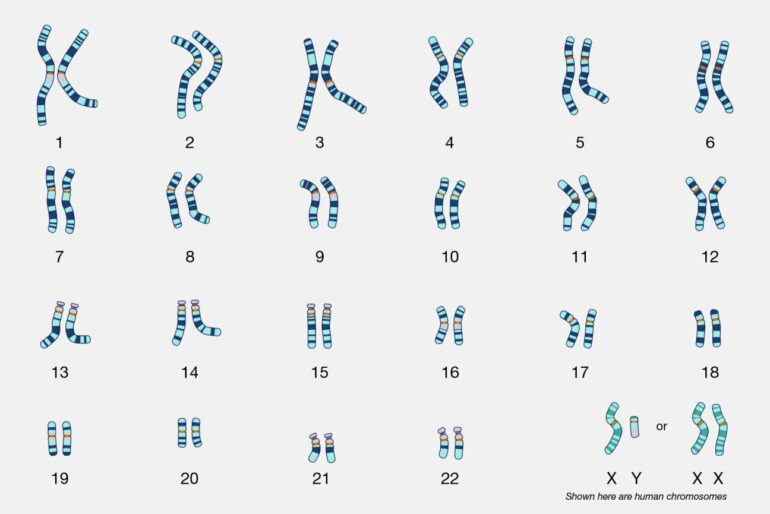Human sex chromosomes originated from a pair of autosomes, the ordinary or non-sex chromosomes that contain the majority of our genome and come in identical pairs. That ancestral pair of autosomes diverged to become two different chromosomes, X and Y. Even though X and Y have grown apart from each other and taken on unique functions—namely, determining sex and driving sex differences in males and females—they also retain shared functions inherited from their common ancestor.
New research from Whitehead Institute Member David Page, who is also a professor of biology at the Massachusetts Institute of Technology and a Howard Hughes Medical Investigator, and postdoc in his lab Adrianna San Roman sheds light on the sex chromosomes’ shared role as influential gene regulators.
The research, published in Cell Genomics on December 13, shows that genes expressed from the X and Y chromosomes impact cells throughout the body—not just in the reproductive system—by dialing up or down the expression of thousands of genes found on other chromosomes.
Furthermore, the researchers found that the gene pair responsible for around half of this regulatory behavior, ZFX and ZFY, found on the X and Y chromosome respectively, have essentially the same regulatory effects as each other. This suggests that ZFX and ZFY inherited their role as influential gene regulators from their shared ancestor and have independently maintained it, even as their respective chromosomes diverged, because that regulatory role is critical for human growth and development. The genes regulated by ZFX and ZFY are involved in all sorts of important biological processes, showing that the sex chromosomes contribute widely to functions beyond those related to sex characteristics.
Page and San Roman measured how X and Y chromosomes affected global gene expression by graphing how each gene’s expression changed in cells depending on the number of X or Y chromosomes present. For this work, they used tissue samples from people who naturally have variation in their number of sex chromosomes: people born with anywhere from one to four X chromosomes and zero to four Y chromosomes. These sex chromosome variations are found throughout the human population, and they lead to a variety of health disorders but—unlike duplications of most other chromosomes—are compatible with life.
“By using the natural variation of sex chromosome composition in the human population, we were able to mathematically model how the number of X and Y chromosomes impacts expression of genes in a way that’s never been done before. By taking this approach, we gained new insights into the massive impact that X and Y genes have broadly throughout the genome,” San Roman says.
For this project, the researchers looked at two cell types that they chose for the ease of sample acquisition—lymphoblastoid cells, a type of immune cell, and skin-cell derived fibroblasts, which help form our connective tissues—and measured how gene expression changed in each cell type with each additional X or Y.
They found that thousands of genes changed their expression levels in response to changes in the number of X and/or Y chromosomes present. The effects scaled linearly, meaning that each additional X or Y chromosome changed gene expression by the same amount. Which genes were affected, and by how much, were different for each of the cell types, suggesting that each type of cell in the body may have a unique response to gene regulation by X and Y chromosome genes.
However, for a given gene in a given cell type, the effect of an additional X tended to be similar to the effect of an additional Y. This was a surprising finding for the researchers, who had expected that differences in how genes on X and Y regulate other genes might help to explain some of the sex differences that are seen in health and disease. Males and females have, for example, different risks of developing certain diseases, different symptoms upon developing the same disease, and different reactions to certain medicines.
There are many differences between male and female cells that are not yet explained, and gene regulators on X and Y that are tweaking gene expression throughout the body seem like promising candidates to be contributing to these differences.
Instead, Page and San Roman narrowed in on the gene pair ZFX and ZFY as being responsible for about half of the effect of X and Y on widespread gene expression, and the pair appear to be functionally equivalent–although ZFX sometimes had a modestly stronger effect than ZFY. Other genes on X and Y are likely to be widespread gene regulators as well, making up the other half of the effect.
These other gene regulators may, like ZFX and ZFY, be X-Y pairs that play essentially equivalent roles. After all, gene regulation is an important function, and the regulatory roles that X and Y inherited from their shared ancestor may need to be carried out in precisely the same way for fetal viability, regardless of how else X and Y grow apart.
However, the researchers suspect that some X and Y genes must modify gene expression in different ways from each other, or to different degrees, in order to explain the many sex differences seen in male and female cells. The challenge is that, because the strongest effect of X and Y on widespread gene expression is shared, it will be harder for researchers to tease out the ways in which the two chromosomes affect gene expression differently.
“The effects on the genome that may explain sex differences are more subtle than we had previously predicted,” San Roman says. “One point of interest for future study is that although we saw that X and Y had highly correlated effects on gene expression, we observed larger effects with X as opposed to Y copy number, and this may contribute to sex differences.”
Rethinking sex chromosomes: Inactive versus active X
A subtlety thus far not discussed is that when Page and San Roman think about the sex chromosomes, they no longer think of X as most people think of it. Their work has convinced them that our current understanding of the sex chromosomes is imprecise. Although the human sex chromosomes are defined as X and Y, in fact there are two types of X chromosomes, and only one of them differs between typical males and females. Every human in the world has one “active X” chromosome. This chromosome is, like an autosome, universally present and so its presence has no bearing on sex.
What differs between typical males and females is the chromosome that pairs with the active X: typical males have a Y chromosome and typical females have an “inactive X” chromosome, which is genetically identical to the active X but has the majority of its genes turned off. In people who have atypical compositions of sex chromosomes, any additional X chromosomes will always be inactive X chromosomes—so when the researchers measured the effect of adding more X chromosomes, they were actually measuring the effect of adding more inactive X chromosomes.
The inactive X and the Y, rather than the X and Y, are more accurately the sex chromosomes that the researchers found to be modifying widespread gene expression. Furthermore, Page and San Roman found that the inactive X and the Y both regulate the expression of many genes on the active X chromosome, just as they do on all of the autosomes. (This expands on previous work from Page and San Roman that focused on the relationship between the inactive and active X.) In summary, the active X chromosome behaves like an autosome, while the inactive X chromosome and the Y chromosome function as two sides of the same coin, both as sex chromosomes and as gene regulators.
“These chromosomes have historically been known as the ‘inactive’ X and the ‘gene-poor’ Y chromosomes, and given little attention beyond how they contribute to sex differentiation, so it was stunning to us to see how wide their network of influence was,” Page says. “These chromosomes contain genes like ZFX and ZFY that are global gene regulators, and I think as we learn more about them, it’s going to completely change how we think about the genetics of the human X and Y chromosomes.”
More information:
Adrianna K. San Roman et al, The human Y and inactive X chromosomes similarly modulate autosomal gene expression, Cell Genomics (2023). DOI: 10.1016/j.xgen.2023.100462
Provided by
Whitehead Institute for Biomedical Research
Citation:
Sex chromosomes responsible for much more than determining sex, study shows (2023, December 15)



